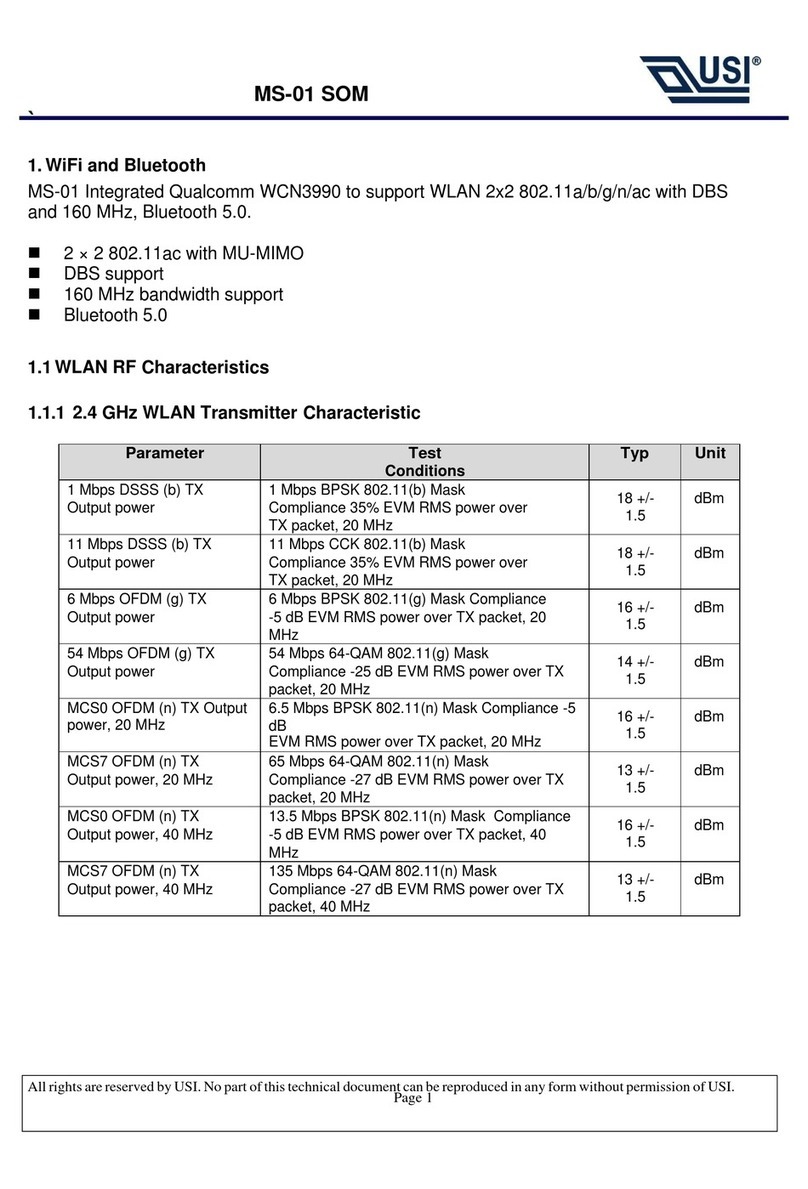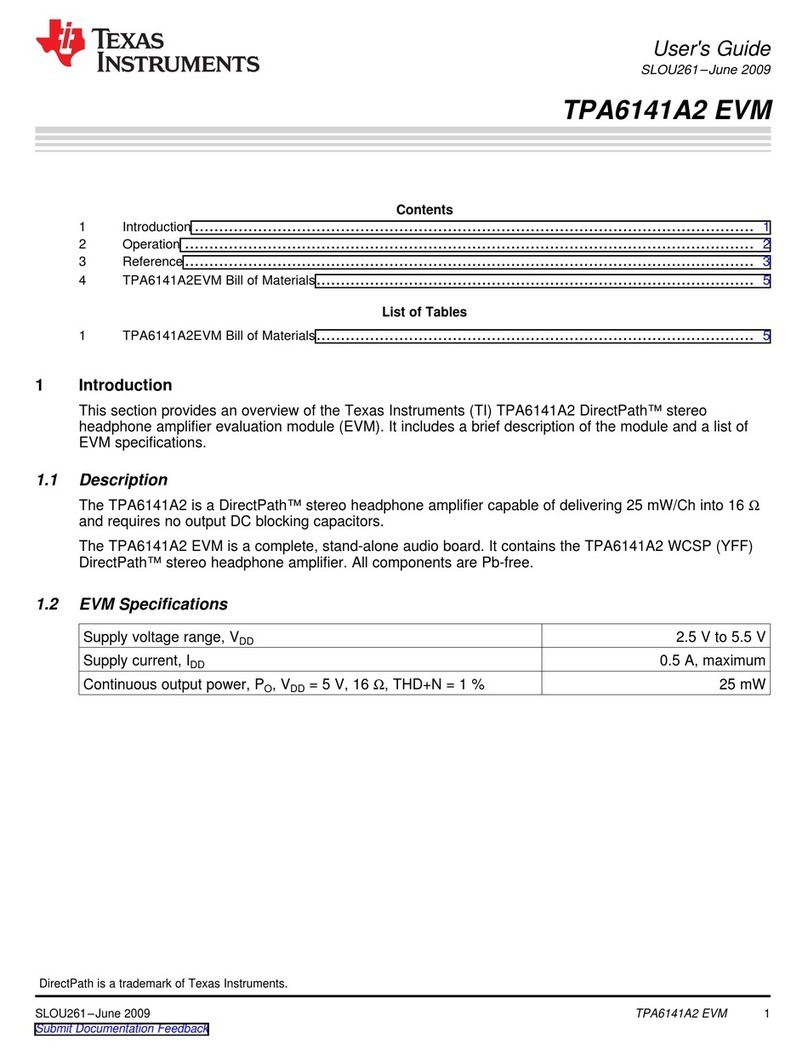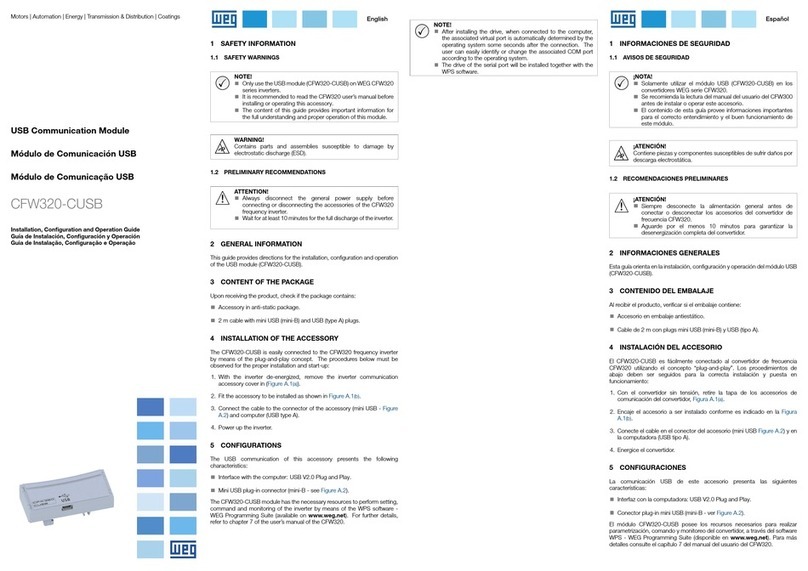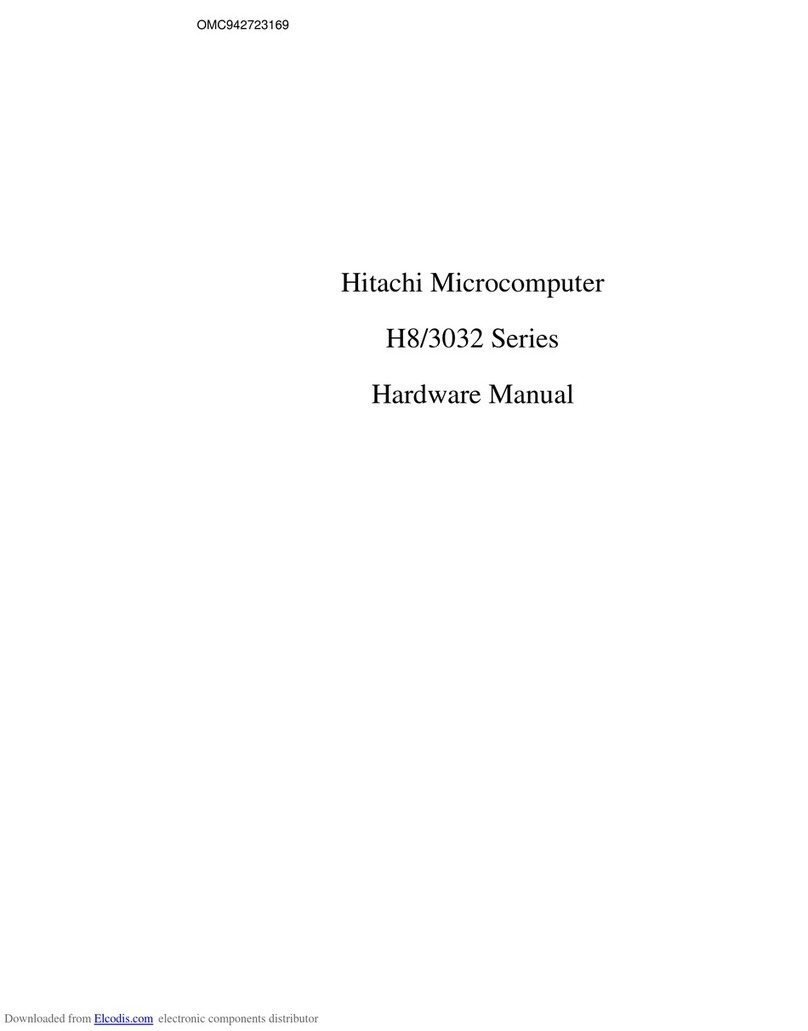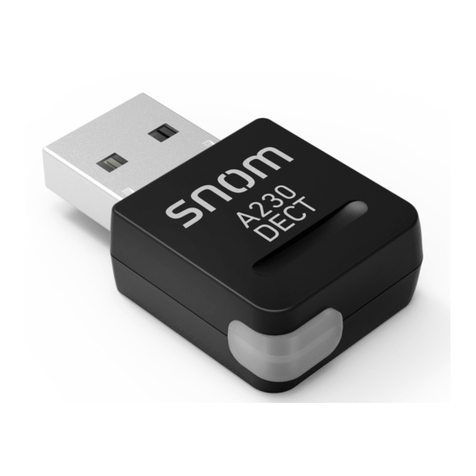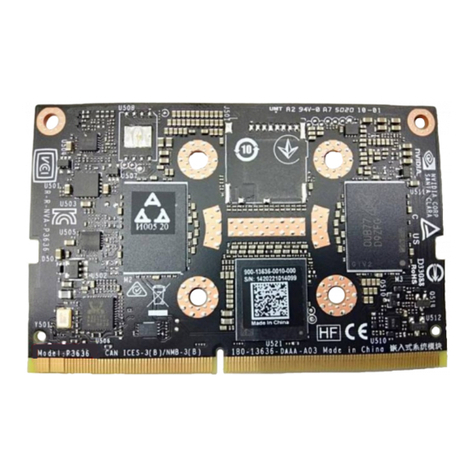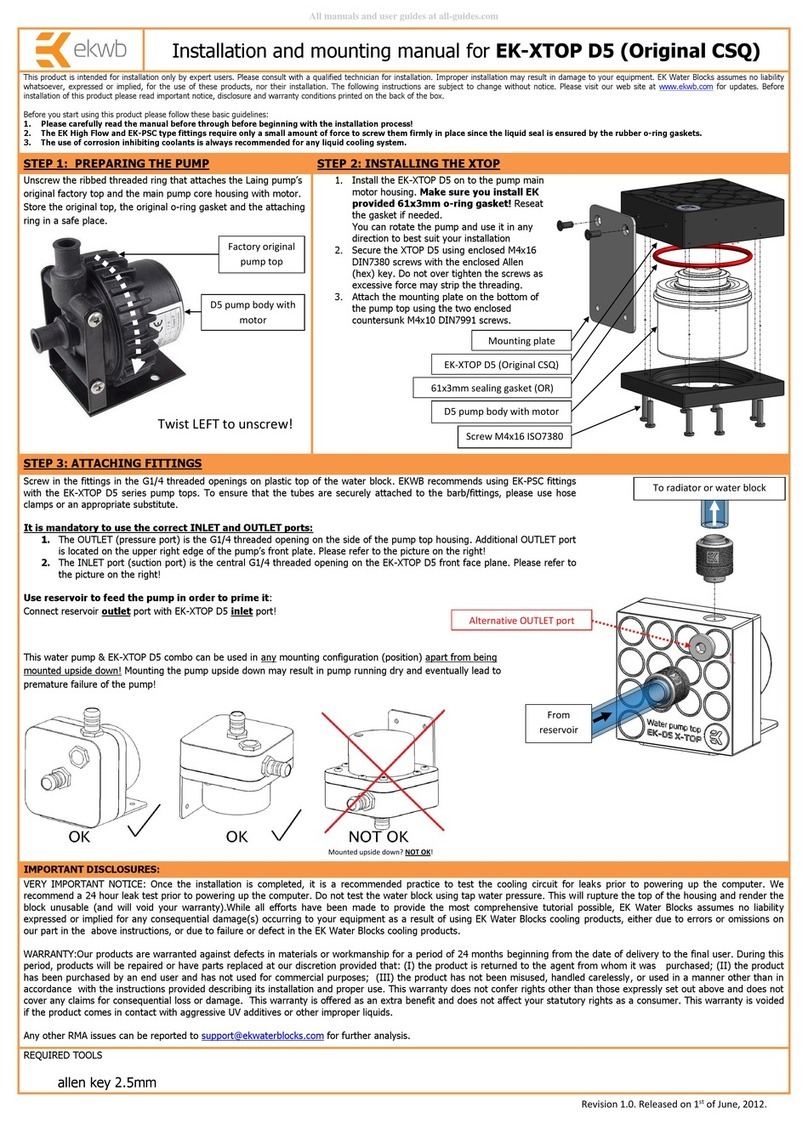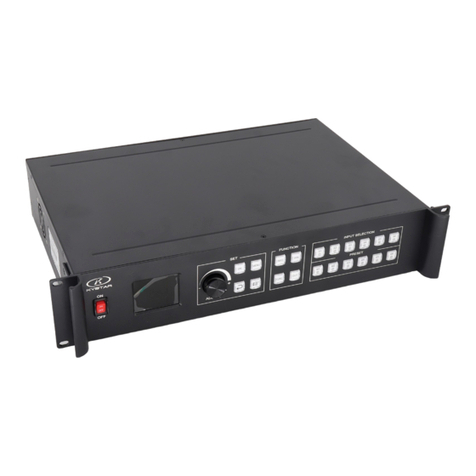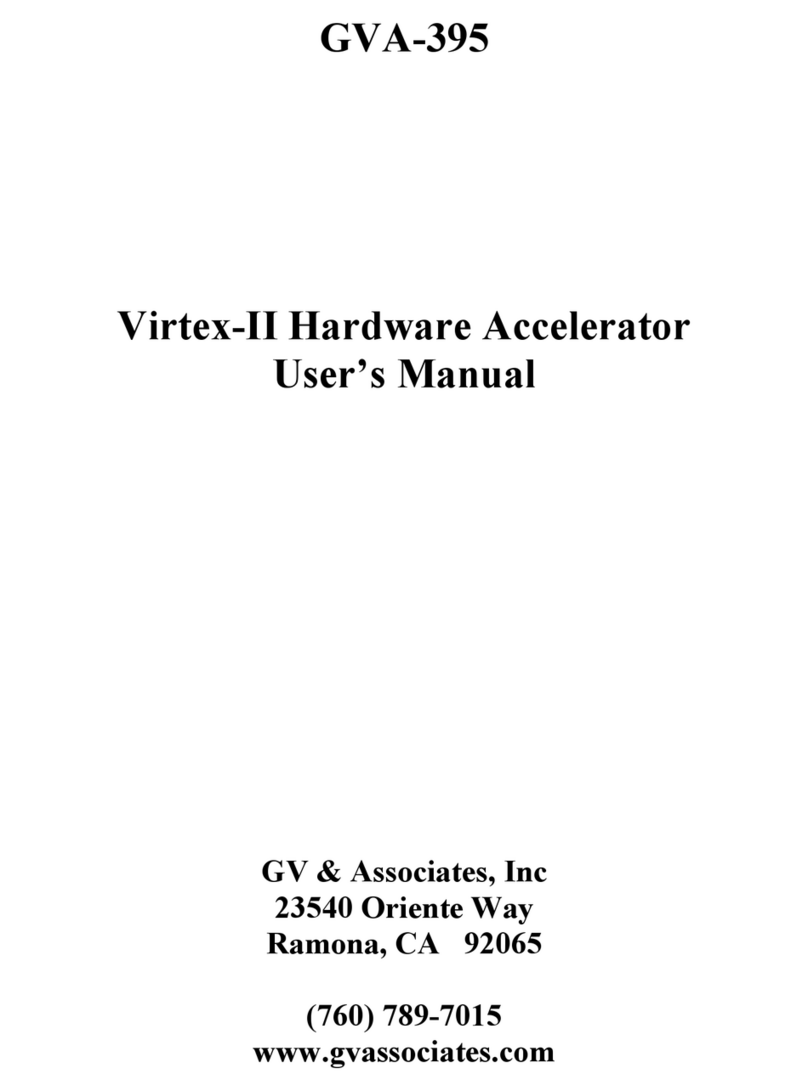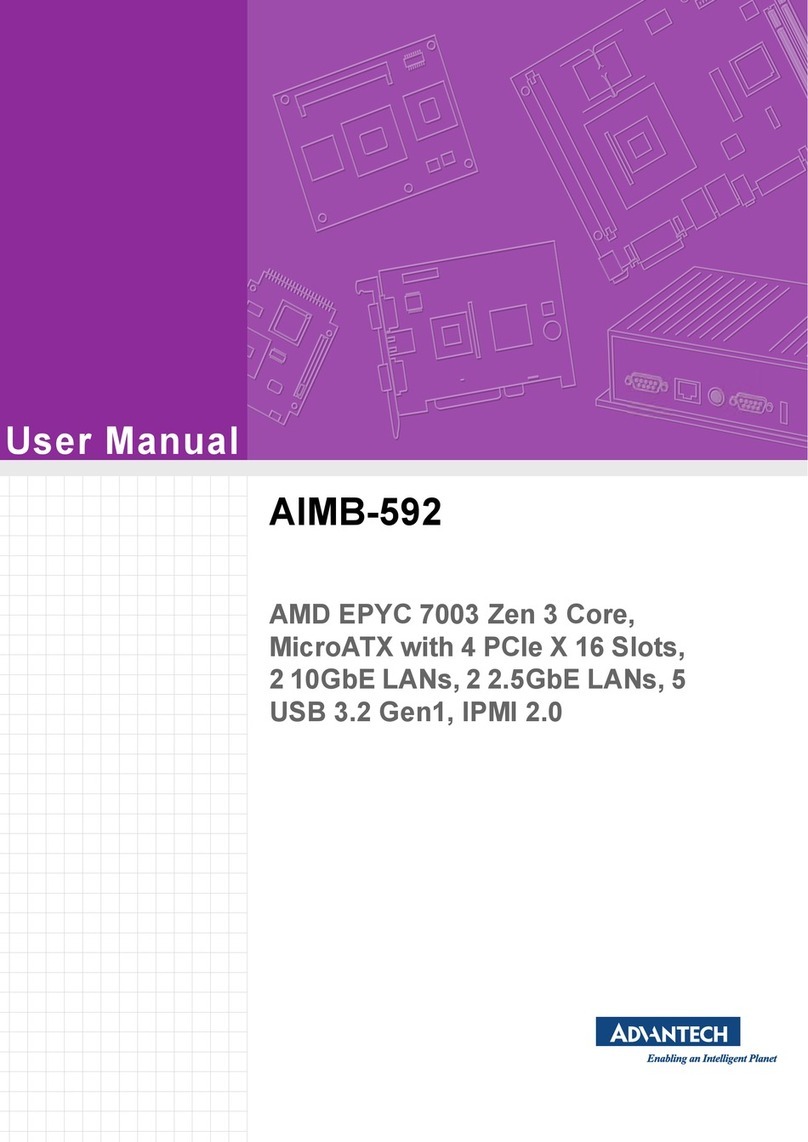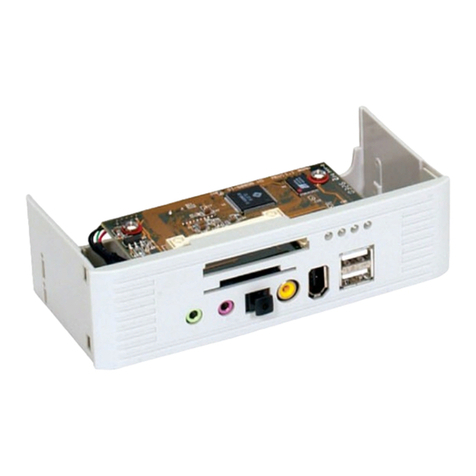sparkfun H3LIS331DL User manual

H3LIS331DL Accelerometer Breakout Hookup
Guide
Introduction
The H3LIS331DL is a high-g accelerometer with I2C and SPI interface
options. It offers an adjustable output range of 100, 200, or 400g, and an
adjustable data rate of up to 1kHz.
Required Materials
SparkFun Triple Axis Accelerometer Breakout -
H3LIS331DL
SEN-14480
…
Page 1 of 1
2

H3LIS331DL Hookup Guide SparkFun Wish List
Please check the wish list below for items required to follow this tutorial.
SparkFun Triple Axis Accelerometer Breakout - H3LIS331DL
SEN-14480
A
rduino Pro 328 - 3.3V/8MHz
DEV-10914
It's blue! It's skinny! It's the Arduino Pro! SparkFun's minimal design a…
A
rduino Stackable Header Kit
PRT-10007
These headers are made to work with the Arduino Main Board, Ardui…
Breadboard - Mini Modular (Green)
PRT-12046
This green Mini Breadboard is a great way to prototype your small pro…
USB micro-B Cable - 6 Foot
CAB-10215
USB 2.0 type A to micro USB 5-pin. This is a new, smaller connector f…
SparkFun Beefy 3 - FTDI Basic Breakout
DEV-13746
This is SparkFun Beefy 3 FTDI Basic Breakout for the FTDI FT231X…
Break Away Headers - Straight
PRT-00116
A
row of headers - break to fit. 40 pins that can be cut to any size. Us…
Jumper Wires Premium 6" M/M Pack of 10
PRT-08431
This is a SparkFun exclusive! These are 155mm long jumpers with m…
Tools
No special tools are required to follow this tutorial. You will need a soldering
iron, solder, and general soldering accessories.
Suggested Reading
We suggest reviewing the tutorials below to ensure that you’re up-to-date
with all of the skills necessary to follow this hookup guide.
Soldering Iron - 30W (US,
110V)
TOL-09507
Solder Lead Free - 15-gram
Tube
TOL-09163
Page 2 of 1
2

Hardware Overview
The H3LIS331DL breakout is fairly simple.
H3LIS331DL Sensor IC - This is the sensor IC. Its operating voltage only
extends up to 3.6V, so to use it with a 5V Arduino or Arduino clone, you’ll
need some kind of voltage translation! It is perfectly centered on the PCB.
How to Solder: Through
-
Hole Solderin
g
This tutorial covers everything you
need to know about through-hole
soldering.
Installing an Arduino Library
How do I install a custom Arduino
library? It's easy!
Serial Peripheral Interface
(SPI
)
SPI is commonly used to connect
microcontrollers to peripherals such
as sensors, shift registers, and SD
cards.
Logic Levels
Learn the difference between 3.3V
and 5V devices and logic levels.
I2C
A
n introduction to I2C, one of the
main embedded communications
protocols in use today.
Page 3 of 1
2

I C Pull-up Resistors - The board includes pull-up resistor so you don’t
need to add them externally.
I C Pull-up Resistor Isolation Jumper - If necessary, the I C pull-up
resistors can be removed from the circuit by removing the solder from this
jumper.
SparkFun Standard I C Header - Most boards which can be
communicated to via I C use this pinout, making it easy to stack them or
connect them in a daisy chain.
SA0 Jumper - Closing this jumper changes the I C address of the sensor
from 0x19 to 0x18.
2
22
2
2
2
Page 4 of 1
2

CS Jumper - Removing the solder from this jumper enables SPI mode.
When the part’s CS line is low at boot, it enables SPI mode.
SA0 Pin - When the chip is in SPI mode, this goes from being the address
select pin to being the MISO pin.
CS Pin - Chip select for SPI mode. Unused in I C mode.
Interrupt Pins - These pins are tied to interrupts that can be setup by the
software library to trigger on various conditions.
2
Page 5 of 1
2

Library Overview
Here’s a list of the functions supported by the Arduino library for the LIS331
family.
begin(comm_mode mode) - Sets the communications mode to be used by
the library ( LIS331::USE_I2C or LIS331::USE_SPI ), sets the power mode
to normal, enables the axes, sets the sampling rate to 50Hz, and resets all
the other registers to 0.
setI2CAddr(address) - Sets the I C address. By default this is going to be
0x19. If the SA0 jumper is soldered closed, it is 0x18. This function must
be called before begin() so the library knows what address to use for
communications.
setSPICSPin(pin) - Sets the SPI mode chip select pin. This function
must be called before begin() so the library knows which pin to use
for communications.
axesEnable(bool enable) -Pass true to enable the axes or false to
disable them.
setPowerMode(power_mode pmode) - Sets the power mode of the chip. This
affects the data rate as well. Options are:
•LIS331::POWER_DOWN - Minimizes chip power usage but no data or
communications are possible
•LIS331::NORMAL - Normal power mode. Data rate is set by the
setODR() function.
•LIS331::LOW_POWER_0_5HZ - Low power mode, 0.5Hz data rate.
•LIS331::LOW_POWER_1HZ - Low power mode, 1Hz data rate.
•LIS331::LOW_POWER_2HZ - Low power mode, 2Hz data rate.
•LIS331::LOW_POWER_5HZ - Low power mode, 5Hz data rate.
•LIS331::LOW_POWER_10HZ - Low power mode, 10Hz data rate.
setODR(data_rate drate) - Sets the data rate for the part, when in normal
power mode only. Options are:
•LIS331::DR_50HZ - Set the data rate to 50Hz.
•LIS331::DR_100HZ - Set the data rate to 100Hz.
•LIS331::DR_400HZ - Set the data rate to 400Hz.
•LIS331::DR_1000HZ - Set the data rate to 1000Hz.
readAxes(int16_t &x, int16_t &y, int16_t &z) - Pass three int16_t
variables to this function and those variables will be populated with the
appropriate value from the accelerometer.
convertToG(maxScale, reading) - Converts from raw data to an actual
g-reading. The first parameter is the maximum reading for the current
mode, as set by the setFullScale() function. Options are 6/12/24g for the
LIS331HH and 100/200/400g for the H3LIS331DL.
2
Page 6 of 1
2

setHighPassCoeff(high_pass_cutoff_freq_cfg hpcoeff) - Set the
coefficient for the high pass filter. The actual cutoff frequency is dependent
upon the data rate set by setODR() . The cutoff frequency is (fs)/(6*Hpc),
where fs is the sampling frequency and Hpc is the high pass coefficient as
set by these constants:
•LIS331::HPC_8 - Sets coefficient to 8.
•LIS331::HPC_16 - Sets coefficient to 16.
•LIS331::HPC_32 - Sets coefficient to 32.
•LIS331::HPC_64 - Sets coefficient to 64.
enableHPF(bool enable) -true to enable, false to disable.
HPFOOnIntPin(bool enable, intSource) - Does the high pass filter apply
to the signal the interrupt is based on? true to enable, false to disable,
and the second parameter is 1 or 2 depending on which interrupt you wish
to apply this setting to.
intActiveHigh(bool enable) -Pass true to set the interrupt pin to active
high, false to set it as active low. Default value is active high.
intPinMode(pp_od _pinMode) - Are the interrupt pins open-drain or push
pull? Pass LIS331::PUSH_PULL or LIS331::OPEN_DRAIN .
intSrcConfig(int_sig_src src, pin) - What sort of thing triggers an
interrupt, and which pin shows the interrupt. The options are:
•LIS331::INT_SRC - Interrupt source is the same as the pin number.
•LIS331::INT1_2_SRC - Either interrupt will be reflected on the pin.
•LIS331::DRDY - The “new data ready” signal will be reflected on the
pin.
•LIS331::BOOT - The boot mode status of the part is reflected on the
pin.
setFullScale(fs_range range) - Sets the range of the part, as listed
below:
•LOW_RANGE - +/-6g for the LIS331HH or +/-100g for the H3LIS331DH.
•MED_RANGE - +/-12g for the LIS331HH or +/-200g for the
H3LIS331DH.
•HIGH_RANGE - +/-24g for the LIS331HH or +/-400g for the
H3LIS331DH.
bool newXData() - returns true if new X data is available since last read
of X data register.
bool newYData() - same as newXData() for Y axis.
bool newZData() - same as newZData() for Z axis.
enableInterrupt(int_axis axis, trig_on_level trigLevel, interrupt, bool enable)
- axis can be LIS331::X_AXIS , LIS331::Y_AXIS , or LIS331::Z_AXIS .
trigLevel can be LIS331::TRIG_ON_HIGH or LIS331::TRIG_ON_LOW ,
interrupt can be 1 or 2, and enable is true to enable the interrupt and
false to disable it.
setIntDuration(duration, intSource) -duration can be any value from
0-127, and represents the time in number of samples that the sensor must
read above or below the threshold set by the user. intSource is 1 or 2.
setIntThreshold(threshold, intSource) -threshold is the absolute
magnitude above or below which an interrupt will occur, divided by 16. It
can range from 0-127. intSource is 1 or 2.
Examples
Hardware Hookup
Page 7 of 1
2

The H3LIS331DL supports I C, SPI, and three-wire SPI data transfer. The
library supports I C and SPI mode. Obviously, since SPI requires four wires
and I C only requires two, there are different circuit configurations for each
mode. Now would be a good time to solder the female headers to the
Arduino Pro 3.3V/8MHz and breakaway headers to the H3LIS331DL sensor
before connecting the boards together.
ICMode
The board is labeled for I C mode. Here you can see it connected to a 3.3V
Arduino Pro. Note that connecting the board to a 5V Arduino can damage it.
SPI Mode
In SPI mode, the SDA pin becomes MOSI, the SCL pin becomes clock, the
address select pin SA0 become MISO, and the CS pin is used for chip
select.
Example Code
Note: This example assumes you are using the latest version of the
Arduino IDE on your desktop. If this is your first time using Arduino,
please review our tutorial on installing the Arduino IDE. If you have not
previously installed an Arduino library, please check out our
installation guide.
You will also need FTDI drivers installed in order to upload code to the
Arduino Pro. If this is your first time using an FTDI, make sure to follow
our tutorial: USB Serial Driver Quick Install.
To follow along with the examples, the code requires the LIS331 Arduino
library. Make sure that the library has been installed.
2
2
2
2
2
Page 8 of 1
2

SPARKFUN LIS331 ARDUINO
LIBRARY
For the most part, the example code for SPI mode and I C mode is
identical. The only part that differs is the intial setup where you configure
the pins to be used and the library’s settings.
ICModeSetup
Here’s an example of the same section of code from an I C configured
system. It’s important to note that order matters here: Wire.begin() and
xl.setI2CAddr() must be called before xl.begin() .
#include "SparkFun_LIS331.h"
#include <Wire.h>
LIS331 xl;
void setup()
{
// put your setup code here, to run once:
pinMode(9,INPUT); // Interrupt pin input
Wire.begin();
xl.setI2CAddr(0x19); // This MUST be called BEFORE .begin
() so
// .begin() can communicate with th
e chip
xl.begin(LIS331::USE_I2C); // Selects the bus to be used an
d sets
// the power up bit on the accelero
meter.
// Also zeroes out all acceleromete
r
// registers that are user writabl
e.
SPI Mode Setup
Here we have the first few lines of an SPI mode sketch. Again, order is
important: pinMode() , SPI.begin() , and xl.setSPICSPin() functions
must all be called before the xl.begin() function is called.
2
2
2
Page 9 of 1
2

#include "SparkFun_LIS331.h"
#include <SPI.h>
LIS331 xl;
void setup()
{
// put your setup code here, to run once:
pinMode(9,INPUT); // Interrupt pin input
pinMode(10, OUTPUT); // CS for SPI
digitalWrite(10, HIGH); // Make CS high
pinMode(11, OUTPUT); // MOSI for SPI
pinMode(12, INPUT); // MISO for SPI
pinMode(13, OUTPUT); // SCK for SPI
SPI.begin();
xl.setSPICSPin(10); // This MUST be called BEFORE .begin
() so
// .begin() can communicate with th
e chip
xl.begin(LIS331::USE_SPI); // Selects the bus to be used an
d sets
// the power up bit on the accelero
meter.
// Also zeroes out all acceleromete
r
// registers that are user writabl
e.
After this point, the code for either mode of operation is the same. Note that
this example code includes only the second half of the setup function, and if
you’re copy/pasting from this example, you must copy the other half of the
setup function from one of the above code chunks.
Page 10 of 1
2

// This next section configures an interrupt. It will cause
pin
// INT1 on the accelerometer to go high when the absolute v
alue
// of the reading on the Zaxis exceeds a certain level fo
r a
// certain number of samples.
xl.intSrcConfig(LIS331::INT_SRC, 1); // Select the source o
f the
// signal which appears on pin INT
1. In
// this case, we want the correspon
ding
// interrupt's status to appear.
xl.setIntDuration(50, 1); // Number of samples a value must
meet
// the interrupt condition before a
n
// interrupt signal is issued. At t
he
// default rate of 50Hz, this is on
e sec.
xl.setIntThreshold(2, 1); // Threshold for an interrupt. Thi
s is
// not actual counts, but rather, a
ctual
// counts divided by 16.
xl.enableInterrupt(LIS331::Z_AXIS, LIS331::TRIG_ON_HIGH, 1,
true);
// Enable the interrupt. Parameters
indicate
// which axis to sample, when to tr
igger
// (in this case, when the absolut
e mag
// of the signal exceeds the thresh
old),
// which interrupt source we're con
figuring,
// and whether to enable (true) or
disable
// (false) the interrupt.
Serial.begin(115200);
}
void loop()
{
static long loopTimer = 0;
int16_t x, y, z;
if (millis() loopTimer > 1000)
{
loopTimer = millis();
xl.readAxes(x, y, z); // The readAxes() function transfer
s the
// current axis readings into the
three
// parameter variables passed to i
t.
Serial.println(x);
Serial.println(y);
Serial.println(z);
Serial.println(xl.convertToG(100,x)); // The convertToG()
function
Serial.println(xl.convertToG(100,y)); // accepts as parame
Page 11 of 1
2

ters the
Serial.println(xl.convertToG(100,z)); // raw value and th
e current
Serial.println(" "); // maximum grating.
}
if (digitalRead(9) == HIGH)
{
Serial.println("Interrupt");
}
}
After placing the code into the Arduino IDE, select the board definition and
COM port to upload. Once compiled, check out the sensor readings by
opening up a serial monitor set to 115200 baud.
Resources and Going Further
Now that you’ve successfully got your H3LIS331DL up and running, it’s
time to incorporate it into your own project!
• For lower dynamic ranges (6-24g) SparkFun offers the LIS331
breakout board, which is library compatible with this one.
For more information, check out the resources below:
• Schematic
• Eagle Files (ZIP)
• H3LIS331DL Datasheet (PDF)
• Product Showcase Video
◦ShawnHymel’s H3LIS331_Ball_Demo.ino - Code used for the
Produce Showcase Demo.
• GitHub Repo
• Arduino Library Code Repo
Need some inspiration for your next project? Check out some of these
related tutorials:
VL6180 Hookup Guid
e
Get started with your VL6180 based
sensor or the VL6180 breakout
board.
RedBoard Santa Trap
A fun holiday project to try for
anyone looking to catch Santa on
Christmas!
LSM6DS3 Breakout Hookup
Guid
e
A
hookup guide for the LSM6DS3,
w
hich features a 3-axis
accelerometer, 3-axis gyroscope,
and FIFO buffer.
LSM303C 6DoF Hookup Guide
A basic guide to get started with the
LSM303C 6 Degrees of Freedom
Breakout.
Page 1
2
of 1
2
12
/
28
/
201
7
https://learn.sparkfun.com/tutorials/h3lis331d
l
-acceleromete
r
-
b
reakout-hooku
p
-guide?_
g
...
Table of contents
Other sparkfun Computer Hardware manuals
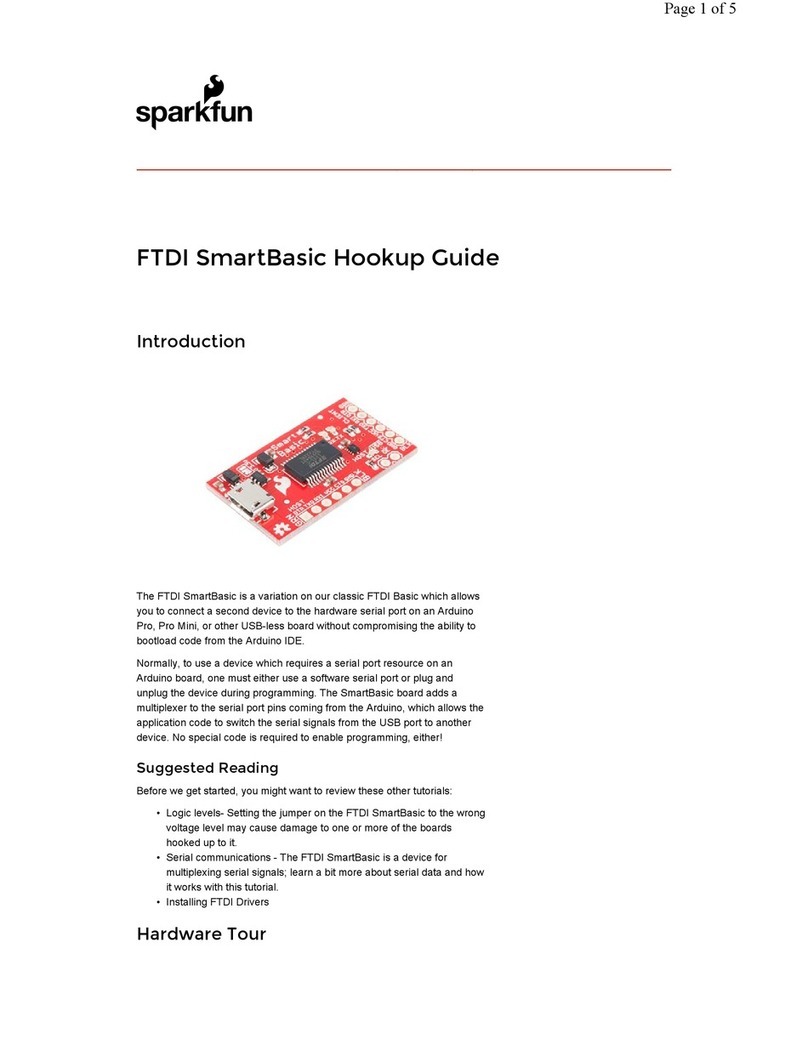
sparkfun
sparkfun FTDI SmartBasic Technical document
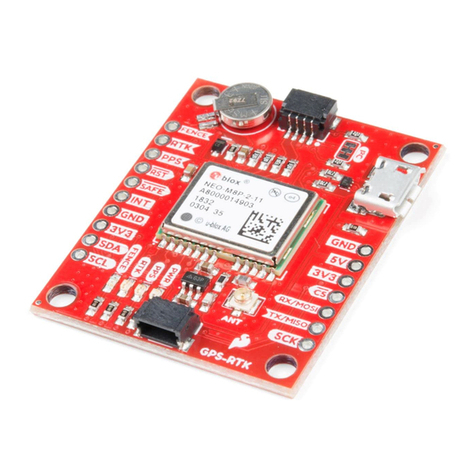
sparkfun
sparkfun NEO-M8P-2 Technical document
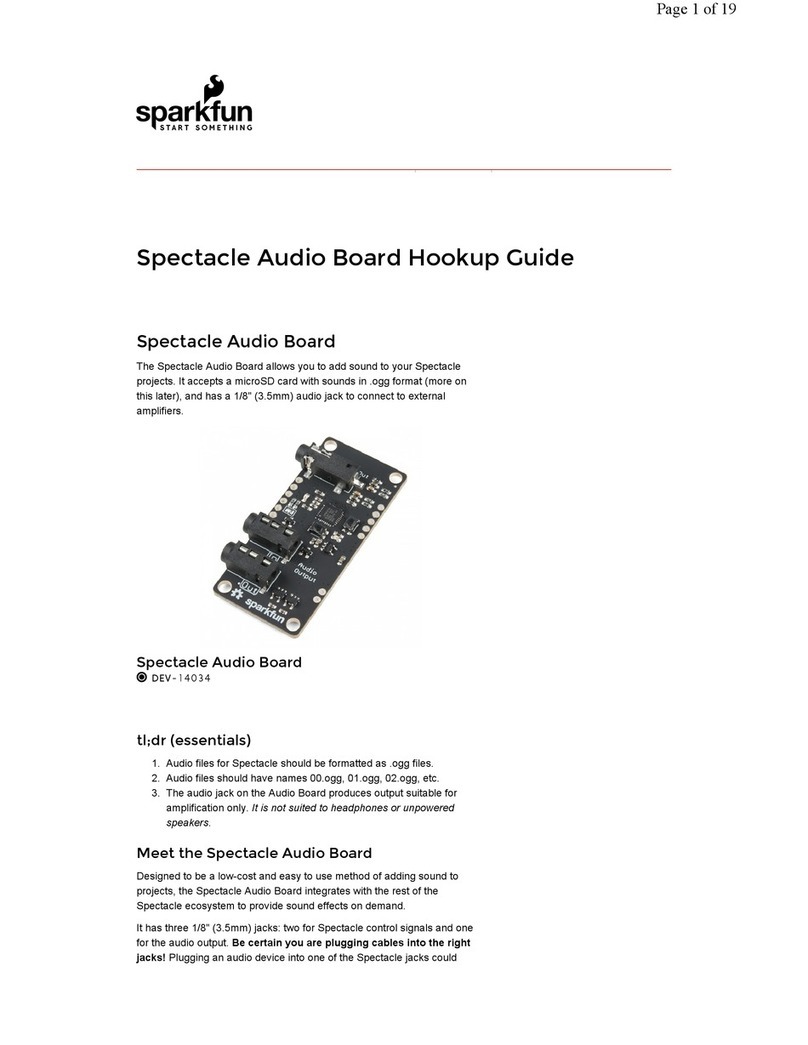
sparkfun
sparkfun DEV-14034 Technical document
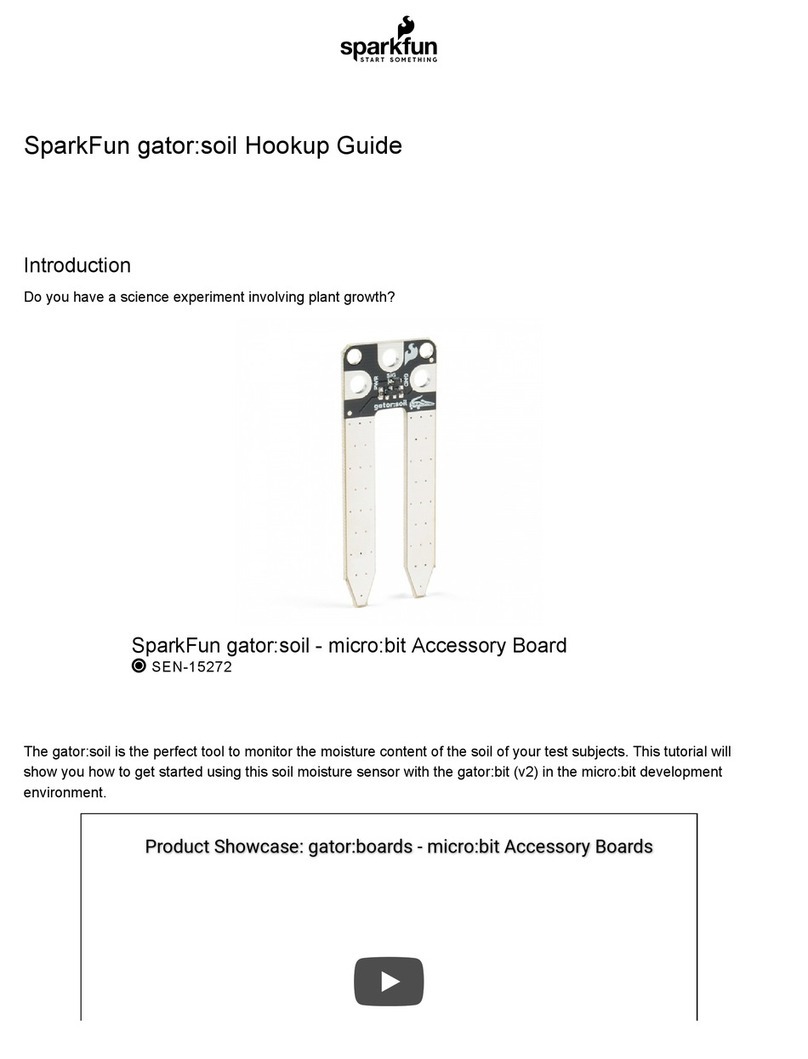
sparkfun
sparkfun Gator:soil Technical document
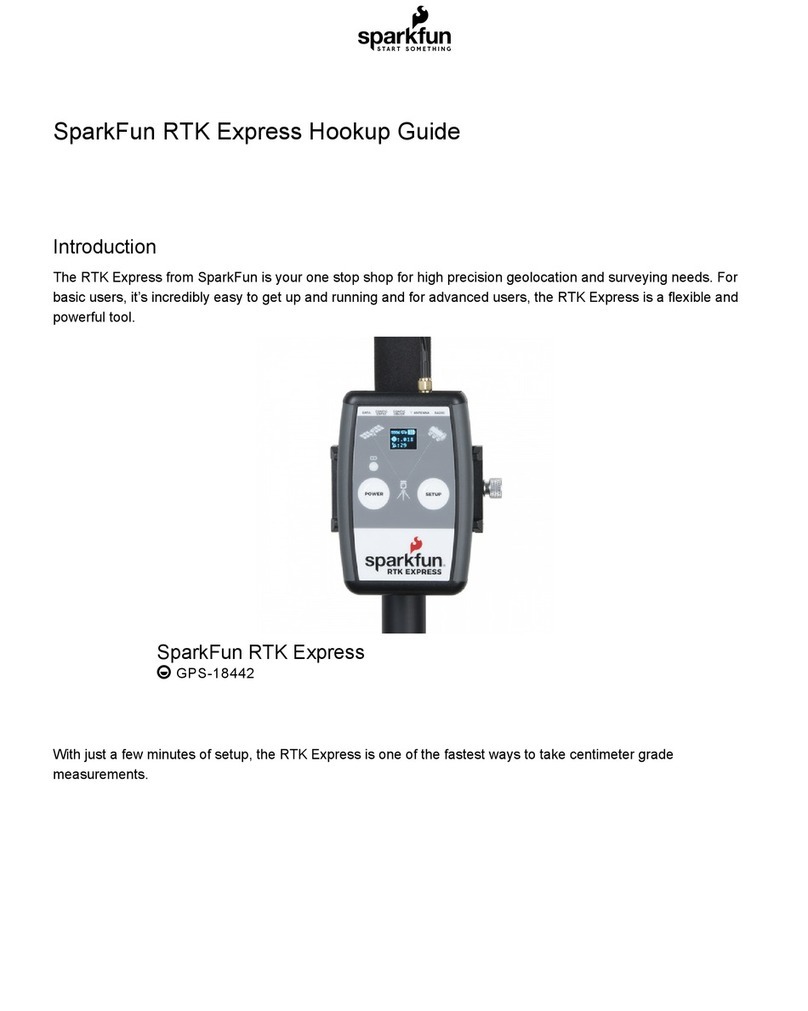
sparkfun
sparkfun RTK Express Technical document
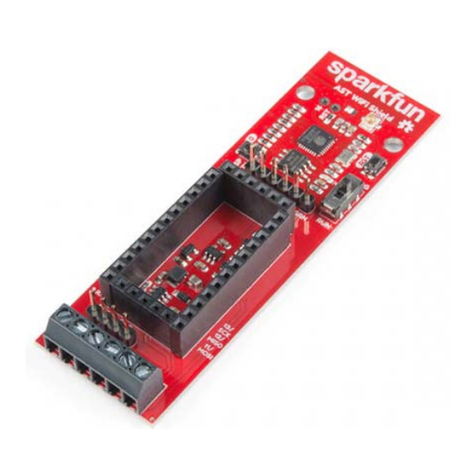
sparkfun
sparkfun AST-CAN485 Technical document

sparkfun
sparkfun WIG-13660 User manual

sparkfun
sparkfun MicroMod SAMD51 Technical document
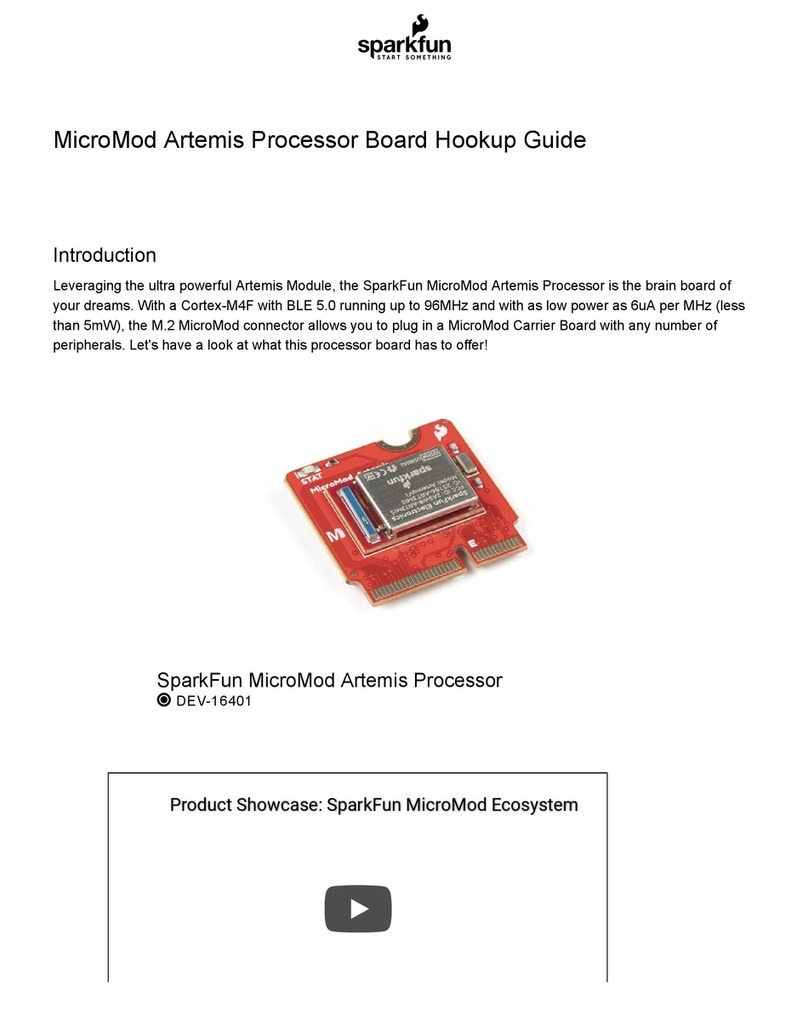
sparkfun
sparkfun MicroMod Artemis Processor User manual
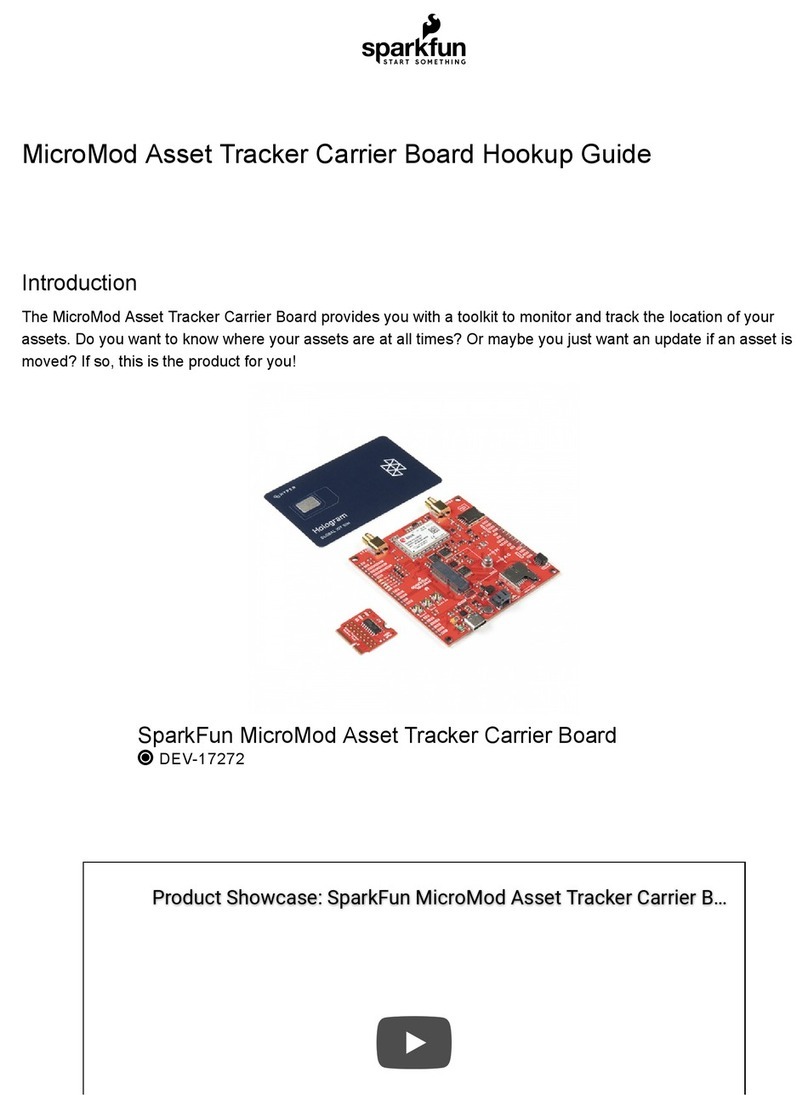
sparkfun
sparkfun DEV-17272 Technical document

